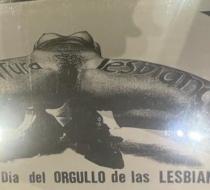Lesbianas Se Difunden and the Feminist Movement in Spain: Taking Back Ownership of the Female Body Favorite
From 1993 to 1998, Spanish activist group Lesbianas Se Difunden (LSD) produced and published a collection of texts and visuals called Non-Grata (Snyder 10), using erotic images of the female body and sexual relationships to capture their audiences’ attention. Within these graphic publications would be calls for queer activism, female freedom, anti-capitalist critiques, and the overall necessity for protest (Snyder 10). What catches the reader’s eye immediately is the use of eroticism and the embrace of sexuality, whether it is displayed through nude bodies, polyamorous relationships, hypersexualization of the female body, bondage, etc. The Museo Reina Sofia in Madrid, Spain houses the Queer Archive, where various editions of Non-Grata can be found. The first issue of Non-Grata displays one of the most powerful images used in the publication. It shows a nude woman squatting down with her legs spread apart and her head thrown back with her breasts bare with the words “escultura” and “lesbiana” written across her legs, with her unshaven vagina directly in the center of the poster. The double meaning of the word “escultura” is interesting to note, as it symbolizes her body is a sculpture as well as the sculpture of the lesbian movement. Furthermore, it is extremely empowering for women to see the female body normalized in the media. Hetero-sexual media depicts women in the most appealing form to men: blemish-free, thin, and hairless. Non-Grata shows women in their most natural forms and displays their bodies in sexual but non-demeaning ways, further proving that the use of the publication is to encourage queer activism, rather than cater to and promote heteropatriarchy. The use of the naked female body in the publication encourages women to take back ownership of their bodies, proving just how powerful the female body is in representing a movement.
The feminist movement in Spain began in the mid-nineteenth century and continues to today, though what defines feminism now is extremely different from decades ago. Through the creation of various subgroups in feminism such as LSD, these movements have spread widely across the country. However, the creation of the subgroups would not have come about without the initial exclusion during third wave feminism, where the feminist movement left minority groups, such as lesbian women, out of the traditional definition of feminism. In order to bring attention to the exclusion of the lesbian women in the feminist movement, it was necessary for LSD to establish themselves as an organization completely separate from it. LSD strived to advocate not only for the rights of lesbian women but for members of the queer community that were underrepresented as well.
The movement tactically uses sexuality and nudity to not only shock their audiences but bring back ownership of the female body and the female erotic. Rather than the body being shamed or used negatively, as typically displayed in heterosexual media, LSD radically transforms the way female bodies can be used in political and social movements. We can witness the fight for inclusion and rights by LSD through the posters and photographs that were published during the 1990s that use sexuality, strength, and the female body to perpetuate the values of the movement.
Photo: Mike Thompson, Queer Archive Museo Reina Sofia, Non-Grata Issue 1 June 1995






